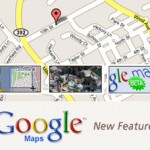 Palm Springs, California — At the TED conference this week, Microsoft outstripped Google’s Street Views application when the software giant unleashed some cool new features for its revamped Bing Maps application, taking panoramic views indoors.
Palm Springs, California — At the TED conference this week, Microsoft outstripped Google’s Street Views application when the software giant unleashed some cool new features for its revamped Bing Maps application, taking panoramic views indoors.
The map service already fine-tuned in December made it more visually spectacular than Google Maps, its established rival, and these new features build on that lead.
Forget the old-time concept of restraining street views on the street, Bing is smartly moving on to providing street-level imagery on its maps product. Bing’s Indoor Panoramas crashes through doors with backpack cameras to get inside panoramic views of venues.

Image via Bing Maps blog…
Also, they are combining Flickr photos through a new Bing Maps application called Streetside Photos. The feature that is now live in a preview version captures real images and video clips from photo-sharing site Flickr and neatly stitches them onto the Bing Map’s street-level view, using a clever combination of geolocation information and approved for reproduction, and overlays them on the existing streetside imagery.
So when you view at a location on Bing, you are not just viewing the present photo set that Microsoft has created, but rather a whole range of photos from Flickr. That might be very useful, for instance, if you want to see what a neighborhood looks like at different times of the day.
This means, for example, you can closely examine on a street and view an image of a particular storefront that was just uploaded to Flickr or Twitpic instead of the standard one. Steetside Photos, which is available for Seattle and San Francisco maps, also includes some nice historical imagery. The photos are associated with their location and laid on top of existing Streetside imagery.
Blaise Agüera y Arcas, architect of Bing Maps, delivered a short demo of four new features at the TED conference, which is taking place in Long Beach and Palm Springs, California, Agüera y Arcas presented another image-stitching program called Photosynth at TED in 2007.
During the demo, Arcas “walked” through a panorama of stalls at Seattle’s Pike Place Market stopping at one stall to pull up real-time video from the market through the Video Overlay Technology. The video camera caught Microsoft colleagues miming noshing on whole crabs. Score one for Big Brother Redmond.
The application behind Streetside Photos can regulate a photo so that it matches to within a few inches, rather than a few feet. This kind of precision is important for augmented reality to work effectively. “The pushpin or the GPS both have quite a bit of inaccuracy,” says Arcas. “It is typical for it to be off by 40 meters or more. Some are even more ambiguous.”
Perhaps most impressively, it can overlay moving video on top of a map, creating a “lens” type of effect, as illustrated in the video at Pike Place Market in Seattle below. Additionaly, the maps’ Streetside mode will integrate with Microsoft’s World Wide Telescope project, so you can see the stars above when you look up in streetside view. It will also combine a feature called “indoor panoramas,” so that you can explore interior locations. (The image above comes from Seattle’s Pike Place Market.)
Photos have been classified, but if you find a photo that should not be included in the app — or find yours and do not want it there — you can click the “Report” button to have the image removed.
On the other side, if you *do* want your images to appear in Streetside Photos, then you will need to make sure they have the correct settings in Flickr. By default, all photos are set to “All Rights Reserved,” preventing Bing from accessing them. Set your photos instead to one of the following:
- Attribution Creative Commons
- Attribution-ShareAlike Creative Commons
- Attribution-NoDerivs Creative Commons
While Agüera y Arcas would not say if there will be a Smart phone app to follow Streetside Photos, it seems like a natural progression.
Arcas explain the concept in the video below:


